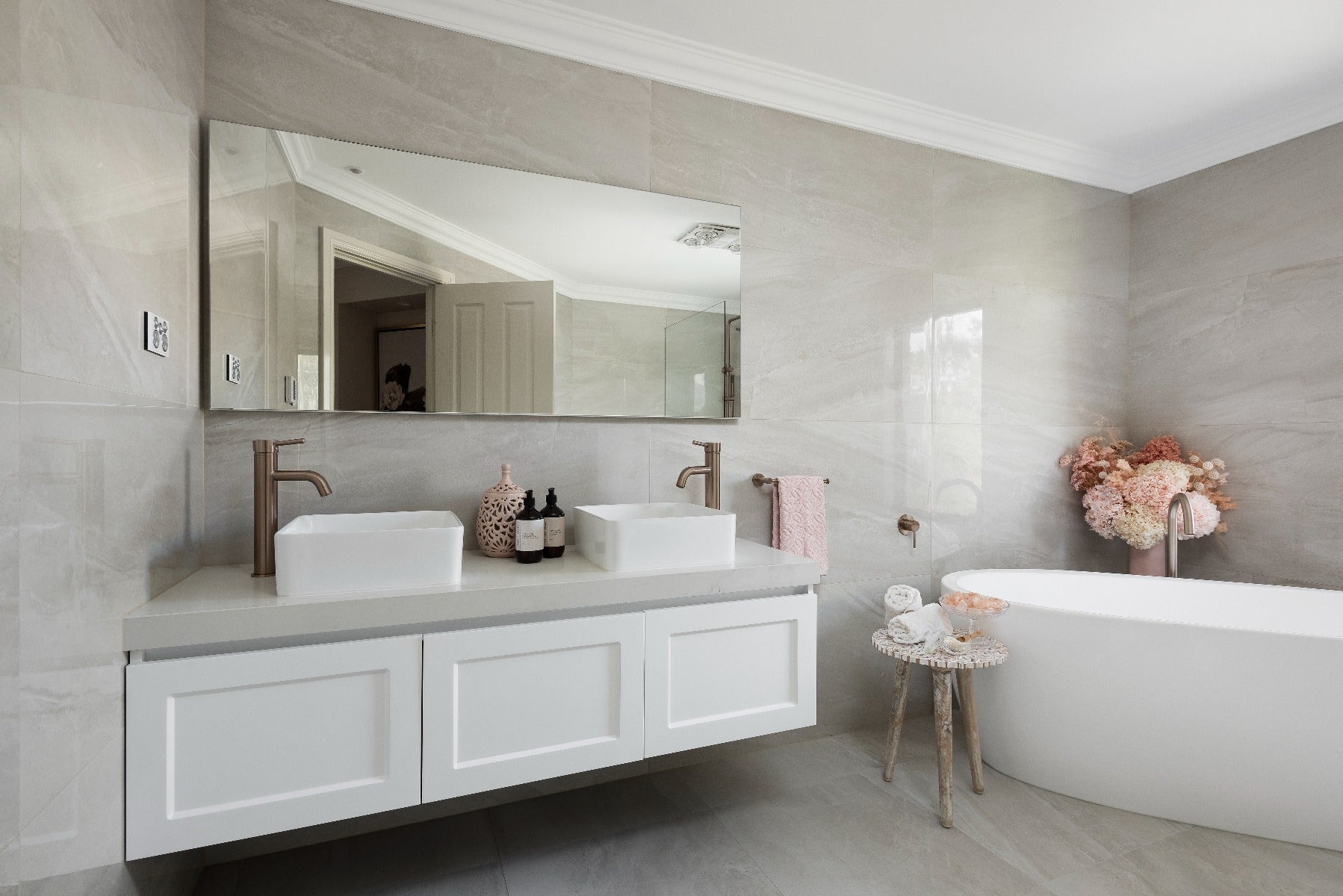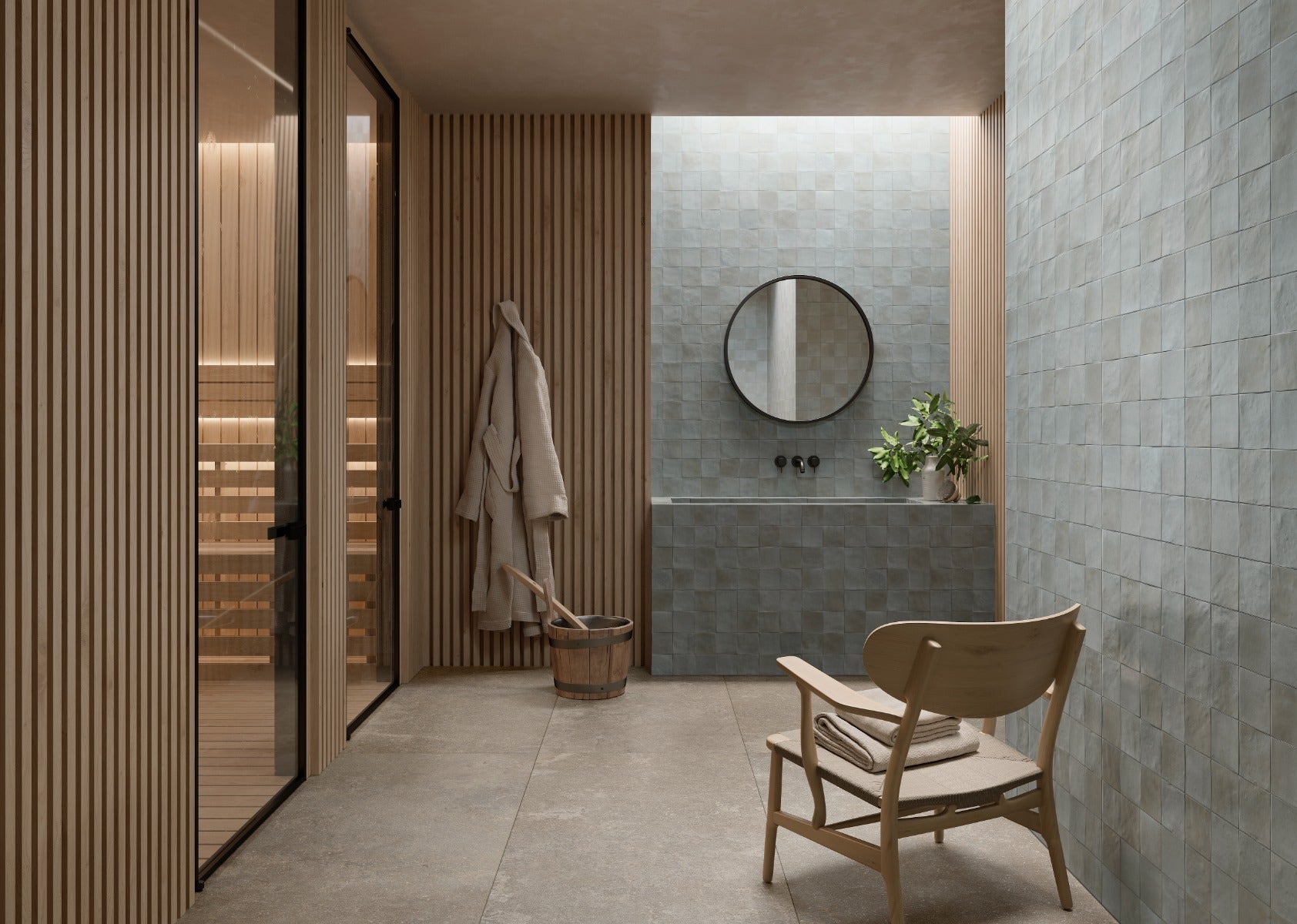Inspiration,
Articles,
DIY Advice
Can You Paint Floor Tiles?
07.01.22

For those wondering, ‘can you paint floor tiles?’ The answer is yes! If you’re looking to freshen up your bathroom or kitchen tiles, but don’t have the time or budget for a full re-tiling, then painting your floor tiles may be a great option.
Offering full design flexibility, you can choose any paint colour, pattern and finish you like. Painting your tiles also allows you the chance to see if you like a colour, and if so, you can take the plunge and use that for re-tiling inspiration later down the track.
Painting your floor tiles is something you can do yourself, so if you’re a DIY fan or searching for a new home renovation project, this is your perfect weekend activity.
So, Can You Paint Floor Tiles?
Absolutely! If you’re looking to refresh your home on a budget, you can paint your floor tiles to breathe new life into the space. If you’re wondering if you can paint floor tiles in your kitchen or bathroom, the answer is yes. However, it’s worth reading over this painting tile floors pros and cons list to decipher if it’s the right option for you.
Pros:
- Ease: painting your tiles is easy to do, and if you’re well-prepared it will take only a few hours.
- Cost-effective: as opposed to a full re-tiling, painting your tiles is a more affordable way to update your bathroom or kitchen.
- Design Flexibility: painting offers the flexibility to change your mind, as well as offering a full breadth of colours.
- DIY: if you’re into home improvements, painting your tiles can be a fun DIY task.
- Sustainable: as opposed to a full-scale remodel, painting your tiles is a sustainable option to minimise waste.
Cons:
- Replacement/ Repair: your painted tiles will require ongoing intervention & re-painting in 6-12 months.
- Delicateness: painted tiles are slightly more delicate, as the paint can crack and wear, as opposed to the sealed, kilned finish of a tile.
- Imperfection: as a DIY task, painted tiles rarely have the picture-perfect finish of the original tile.
- Existing Quality: in order to get a coherent, sleek finish, the tiles must all be in perfect condition to begin with.
- Loss of Existing Patina: painted bricks lose the textural finish and profile of the existing tile, which can be difficult to reclaim.
Painting Floor Tiles (in 7 Simple Steps)
If your bathrooms are looking a bit dated and in need of a refresh but either your budget or timeframe can’t stretch to accommodate for the full re-tiling process, painting your tiles is a great, yet shorter-term option. When it comes to painting floor tiles, the devil’s in the details and the proper preparation is a must!
Painting your tiles offers great design flexibility, allowing you to customise your bathroom however you want. Your dated or unattractive tiles can be spruced up to look as good as new. An added bonus; you’ll be saving on costs whilst being able to get an idea of how new tiles would look. For example, if your tiles are a dated colour and you’re wanting to create a more contemporary feel, white floor tile paint could be a great option.
If you find yourself wondering if you can paint floor tiles to minimise waste, the answer is yes. If you’re big on sustainability, painting your floor tiles will mean that you minimize your environmental footprint by reducing the need for new materials, waste and the byproducts used and created within the re-tiling process.
Tools and products you will need:
■ Brush
■ Bucket
■ Cleaning cloths or rags
■ Drop Sheet (can be fabric or tarpaulin)
■ Masking tape
■ Tile paint (Dulux Renovation Tile Paint is a popular choice)
■ Microfibre cloth/ rag
■ Microfibre paint roller & tray
■ Mould/ Mildew killer
■ Paint stirrer
■ Respirator
■ Safety goggles/ glasses
■ Cleaning gloves (preferably rubber)
■ Sandpaper (suggested 400-grit)
■ Sugar soap
■ Sanding block

- Clean Your Floors
First thing’s first, before you start the process you’ll need to clean your floors to make sure that you eliminate any dirt or grime from the area and ensure a smooth, clean base for painting.
To do this, pop on your cleaning gloves and respirator. Mould and grime killers can be harmful to the respiratory system so it’s best to act with caution.
After scrubbing the area, use your sugar soap to cleanse the area and ensure it is free of any mould, grime or general debris. - Sanding Your Floor Tiles
After thoroughly cleaning the area, use your sanding block and sandpaper to thoroughly sand the area. As well as buffing the tiles and removing any residue, the textured finish allows the paint and primer to properly stick to the surface.
Once you have thoroughly and evenly sanded the area, use your microfibre cloth to wipe away any residue or dust to provide a smooth finish. - Repair/Replace Missing Grout or Cracked Tiles
To create a seamless, cohesive style, ensure that your grout and tiles are intact and not cracked or broken.
If your kitchen or bathroom has cracked tiles or missing grout, consider replacing or repairing them.
You can either do this yourself or get a professional in to fit the replacement tiles. - Apply a Good Primer
When it comes to painting your floor tiles, primer is key! This will help create a level surface and ensure that your paint properly adheres to the surface of the tile.
To apply the primer, you must first stir to ensure that it is properly mixed. From here, pour the primer into your tray and use a brush and roller to apply the primer directly onto your tiles. For extra safety feel free to wear your respirator, otherwise, consider opening doors and windows to allow for proper ventilation.
A top tip for this stage and moving into the next is to use masking tape to seal off the areas where the floors and walls meet to prevent any paint or primer accidentally coming into contact with your walls. - Paint Your Tiles
To ensure proper application, thoroughly mix the paint. In the same process as the primer, pour the paint into your tray and use your brush and roller to apply directly to the tiles.
To achieve the optimum coverage, apply two coats and finish off the painting by rolling over the tiles a final time with a clean roller to ensure the paint is evenly applied. - Seal Your Tiles
To make sure your tiles are durable and water and grime resistant, it’s wise to apply a sealant.
Paint sealants are created to bond perfectly with the coat of paint. They construct a hard glass-like shell atop the paint to prevent ongoing wear and tear.
For even coverage, use your tray and roller to apply the sealant. - Leave Your Floor To Dry
After painting your tiles, it’s best to leave the area for 24 hours to prevent any damage or uneven marks on the surface

Is painting your floor tiles a good idea?
When done properly, painting your floor tiles can be a great idea. Alongside the benefit of cost efficiency, painting your tiles is an easy way to experiment with your bathroom or kitchen design without breaking the bank or making a long-term investment. If done properly, your painted tile floor will still look great 6 months later!
How long does paint over tiles last?
The longevity of painted tiles is largely dependent upon the quality of the painting, the quality of the paint, the foot-traffic of the area and the exposure to the elements.
However, the approximate median amount would be around 6-12 months. This can vary depending on the above factors, but if properly primed, painted and sealed, your painted tiles can last for 12+ months.
If you’re in doubt, why not ask your friends or family and see if they have images from painting their floor tiles before and after to see if you like the effect.
What kind of paint do you use on tile floors?
When it comes to painting your floor tiles, it’s best to use specialist paint to prevent any chipping or cracking. The best floor tile paint for high foot-traffic areas is an oil-based option as it is less prone to damage, however, high-gloss latex paint is another popular choice. If in doubt, contact your local Amber and a representative will be able to offer some guidance depending on your desired finish, style and colour.
Summary
If you’re looking for an easy, cost-effective way to breathe new life into your home’s interior, then painting your tiles may be a great option for you.
Your tiles are an investment in your home and so make sure that you have considered the process before painting them. If you’re thinking, ‘can I paint my floor tiles?’ It's worth doing your research and even discussing it with a professional before getting started.
For guidance on where to start, or if you have any questions about which products are best, please do not hesitate to get in touch with our team of tile experts who can help you from beginning to end.
For tile ideas or inspiration for your renovation, look no further than our inspiration blog and gallery to see just how Amber can transform your space. You can find tile inspiration to suit all rooms, purposes and design styles through the Amber Ultimate Guide to Tiles.
Amber has the answer.

